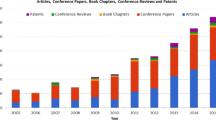Abstract
One of the aims in the AI research, is to understand the principles and mechanisms of intelligence in the human brain. Definitely the brain is a neurocontroller, a collection of neurons which learn to output the right actions or decisions over time. This paper describes recent neurocontrol designs which are considered the state-of-the-art for intelligent control and their plausibility as models of the human brain.
Similar content being viewed by others
Explore related subjects
Discover the latest articles, news and stories from top researchers in related subjects.References
Astrom, K. J. (1988). Towards intelligent control.IEEE Control Systems Magazine.
Barto, A. G., Sutton, R. S., and Anderson, C. W. (1983). Neuronlike adaptive elements that can solve difficult control problems.IEEE Transactions on Systems, Man and Cybernetics, SMC-13, 834–846.
Bertsekas, D. P. and Tsitsiklis, J. N. (1996). Neuro-Dynamic Programming. Athena Scientific.
Carpenter, G. A. and Grossberg, S. (1990). Adaptive resonance theory: Neural network architectures for self-organizing pattern recognition. In Eckmiller, R., Hartmann, G., and Hauske, G., editors,Parallel Processing in Neural Systems and Computers, 383–389. Elsevier Science Publishers B.V. (North Holland).
Dracopoulos, D. C. (1997). Evolutionary Learning Algorithms for Neural Adaptive Control. Springer-Verlag.
Dracopoulos, D. C. and Jones, A. J. (1993). Neuromodels of analytic dynamic systems.Neural Computing & Applications, 1(4), 268–279.
Grossberg, S. (1997). personal communication.
Hertz, J., Kroph, A., and Palmer, R. G. (1991).Introduction to the Theory of Neural Computation. Addison Wesley.
Jordan, M. I. and Rumelhart, D. E. (1992). Forward Models: Supervised learning with a distal teacher.Cognitive Science, 16, 307–354.
Kawato, M. (1990). Computational schemes and neural network models for formation and control of multijoint arm trajectory. In Miller, S. and Werbos, editors,Neural Networks for Control. MIT Press.
Levine, D. S. (1996). Don’t just stand there, optimize something. In Levine, D. and Elsberry, W., editors,Optimality in Biological and Artificial Networks, Erlbaum. (1).
Mendel, J. M. and McLaren, R. W. (1970). Reinforcement learning control and pattern recognition systems. In Press, A., editor,Adaptive Learning and Pattern Recognition Systems, chapter 8. J. M. Mendel and K. S. Fu.
Miller, W., Sutton, R. S., and Werbos, P. J., editors (1990).Neural Networks for Control. MIT Press.
Narendra, K. S. (1992). Adaptive control of dynamical systems using neural networks. In White, D. A. and Sofge, D. A., editors,Handbook of Intelligent Control, Van Nostrand Reinhold, chapter 5.
Prokhorov, D. V. and Wunch II, D. C. (1996). Advanced adaptive critic designs. InWorld Congress on Neural Networks, San Diego, California, Lawrence Erlbaum Associates, Inc. and INNS Press. 83–87.
Psaltis, D., Sideris, A., and Yamamura, A. A. (1988). A multilayered neural net work controller.IEEE Control Systems Magazine, 17–21.
Rumelhart, D., McClelland, J., and the PDP research group (1986).Parallel Distributed Processing-Explorations in the Microstructure Cognition, MIT Press. 1.
Simon, H. (1979).Models of Thought. Yale University Press.
Sloman, A. (1992). The mind as a control system. In Hookway, C. and Peterson, D., editors,Philosophy and the Cognitive Sciences, Proceedings of the 1992 Royal Institute of Philosophy Conference, Cambridge University Press. 69–110.
Sutton, R. S. and Barto, A. G. (1998).Reinforcement Learning: An Introduction. MIT Press/Bradford Books.
WCNN95 (1995). World Congress on Neural Networks. Lawrence Erlbaum Associates, Inc. and INNS Press.
WCNN96 (1996). World Congress on Neural Networks. Lawrence Erlbaum Associates, Inc. and INNS Press.
Werbos, P. (1990a). Neurocontrol and related techniques. In Maren, A., editor,Handbook of Neural Computing Applications, Academic Press. 345–381.
Werbos, P. J. (1990b). Backpropagation through time: What it does and how to do it.Proceedings of the IEEE, 78(10).
Werbos, P. J. (1996a). personal communication.
Werbos, P. J. (1996b). Learning in the brain: An engineering interpretation. In Pribram, K., editor,Learning as Self-Organization. Erlbaum.
Werbos, P. J. (1996c). Neurocontrol, biological intelligence and engineering applications: Evaluation and prognosis. In BMBFProceedings on Neuroinformatiks and AI, Berlin.
Werbos, P. J. (1996d). Optimization: A foundation for understanding consciousness. In Levine, D. and Elsberry, W., editors,Optimality in Biological and Artificial Networks, Erlbaum, chapter 1.
White, D. A. and Sofge, D. A., editors (1992).Handbook of Intelligent Control. Van Nostrand Reinhold.
Widrow, B., Gupta, N., and Maitra, S. (1973). Punish/reward: Learning with a critic in adaptive threshold systems.IEEE Transactions on Systems, Man and Cybernetics, volume 5.
Widrow, B. and Stearns, S. D. (1985).Adaptive Signal Processing. Prentice Hall, first edition.
Author information
Authors and Affiliations
Corresponding author
Rights and permissions
About this article
Cite this article
Dracopoulos, D.C. Neurocontrol: Recent advances and links with the human brain. AI & Soc 11, 63–75 (1997). https://doi.org/10.1007/BF02812439
Issue Date:
DOI: https://doi.org/10.1007/BF02812439




